
A Close Look at the USS Voyager NCC-74656 - By Rick Sternbach.
When the Star Trek art department designs a new ship no detail is ignored. As Voyager's designer Rick
Sternbach reveals, if you look closely at the hull you will see that it is bristling with systems and equipment.
 The Intrepid-class USS Voyager
NCC-74656 underwent a five-month birthing process, gliding across television screens countless times,
been damaged in battle, and has landed on strange alien worlds. Most of the hull components are easily
identified, and have been seen in action, phaser arrays, nacelles, photon torpedo launchers, and the
navigational deflector dish. However there are also many other components that have not been used or received
as much attention, such as the burnt orange-colored reaction control system (RCS) thrusters, or the ovals cut
into deck 9 are extendible airlocks. Even though most of these components won't be featured, Sternbach
none-the-less designed them on his Voyager blueprints and then built by Tony Meininger's Brazil Fabrication, as
well as made into computer generated images of Voyager by Santa Barbara Studios, Foundation Imaging, Digital
Muse, and Digital Magic. The causal viewer may not notice these details, but they're well understood by
Trekkies and those that frequent the numerous technical news groups on the internet.
The Intrepid-class USS Voyager
NCC-74656 underwent a five-month birthing process, gliding across television screens countless times,
been damaged in battle, and has landed on strange alien worlds. Most of the hull components are easily
identified, and have been seen in action, phaser arrays, nacelles, photon torpedo launchers, and the
navigational deflector dish. However there are also many other components that have not been used or received
as much attention, such as the burnt orange-colored reaction control system (RCS) thrusters, or the ovals cut
into deck 9 are extendible airlocks. Even though most of these components won't be featured, Sternbach
none-the-less designed them on his Voyager blueprints and then built by Tony Meininger's Brazil Fabrication, as
well as made into computer generated images of Voyager by Santa Barbara Studios, Foundation Imaging, Digital
Muse, and Digital Magic. The causal viewer may not notice these details, but they're well understood by
Trekkies and those that frequent the numerous technical news groups on the internet.
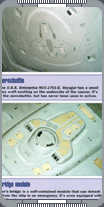
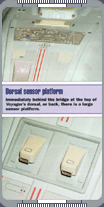 One of the most asked about feature on Voyager is the ship-like outline under the saucer section. The craft is
called the aeroshuttle, originally called an aerowing shuttle, it is designed after a
runabout, with aerodynamic wings and vertical lift engines. The
aeroshuttle has yet to be seen in use, as Sternbach explains possibly because not all of the necessary systems
were installed when Voyager left Deep Space 9. Located in the same area are
two curved rows of sensor pallets, deck 9 windows, and part of the defensive shield grid. It is a little known
fact that the bridge is a free-flying module, complete with maneuvering thrusters. The bridge also contains two
turbolift docking shafts, sensor pallets, formation lights, and escape pods.
One of the most asked about feature on Voyager is the ship-like outline under the saucer section. The craft is
called the aeroshuttle, originally called an aerowing shuttle, it is designed after a
runabout, with aerodynamic wings and vertical lift engines. The
aeroshuttle has yet to be seen in use, as Sternbach explains possibly because not all of the necessary systems
were installed when Voyager left Deep Space 9. Located in the same area are
two curved rows of sensor pallets, deck 9 windows, and part of the defensive shield grid. It is a little known
fact that the bridge is a free-flying module, complete with maneuvering thrusters. The bridge also contains two
turbolift docking shafts, sensor pallets, formation lights, and escape pods.
Aft of the bridge and going down Voyager's spine, include a couple of airlock doors, a large sensor platform,
and the aft torpedo launchers. The two hatches were deliberate copies of the Stage 9 shuttlebay/holodeck doors
in case a part of the hull was built. The shuttlebay exterior shows a large corrugated pressure door and
another standard airlock door, as well as graphic approach guides, formation lights, and Voyager's registry
number.
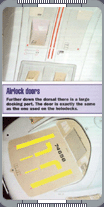
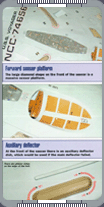 Voyager was the first ship to feature an auxiliary deflector dish on the forward hull, later incorporated in
Sternbach's design of the Nova-class. There's also a large bank of
sensor instruments that provides data on phenomena. At the sides of the auxiliary deflector are transport
emitters, large, flat antennae, that are also positioned in other locations that are responsible for sending and
receiving the transporters' focused matter streams.
Voyager was the first ship to feature an auxiliary deflector dish on the forward hull, later incorporated in
Sternbach's design of the Nova-class. There's also a large bank of
sensor instruments that provides data on phenomena. At the sides of the auxiliary deflector are transport
emitters, large, flat antennae, that are also positioned in other locations that are responsible for sending and
receiving the transporters' focused matter streams.
The phaser arrays come directly from the Type 10 phasers designed for the
USS Enterprise NCC-1701-D - large, multi-emitter strips
strategically placed on the hull for maximum coverage. Warning graphics and systems notices surround the
phasers and placed around the escape pod hatches and various other access panels. Groupings of half-round tubes
generally follow the defensive shield grid are part of the structural integrity field system [SIF], which keep
the ship rigidized during high impulse and warp flight or an attack from an alien starship.
Behind the aeroshuttle are two fan-shaped doors that lead up to a pair of cargo bays, airlocks, SIF
reinforcements, and a faceted hexagon with small flap doors in the center. From here a small, one
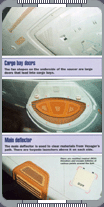 person workpod, or possibly a work bee, for repairing the hull. The workpod is outfitted with a variety of
mechanical and energy tools, that can weld hull plating.
person workpod, or possibly a work bee, for repairing the hull. The workpod is outfitted with a variety of
mechanical and energy tools, that can weld hull plating.
One of the most recognizable features on Starfleet vessels is the navigational deflector dish, a giant energy
device for clearing again interstellar debris from a starship's path. It also functions as the main long-range
sensor. The inner antenna is divided into smaller nested shapes, mostly as an interesting breakup of the dish
than any specific scientific reason. Though Sternbach describes it as his goal to create it to be both
stylistically consistant and technically plausible, and as a small homage to the original Enterprise.
On the engineering hull of Voyager are three sets of plates which support the warp propulsion system. The
forward plate covers the spare warp core, actually a set of replacements parts and not a true "plug 'n' play"
warp reactor. The middle plate contains the antimatter loading port, a large magnetic valve that keeps the
antimatter from coming in contact with matter during the transfer to the storage pods. The aft cover plate
contains the actual operational warp core hatch, for ejecting the warp core seen in "Day of Honor." They also
contain a pair of long plasma flush vents and a pair of emergency antimatter release vents. There are four
landing strut hatches, located aft of the deflector dish. The landing pads were designed to fit to fold
compactly into a single deck.
|
|
"A CLOSE LOOK AT THE USS VOYAGER NCC-74656" - AUGUST 2000 ISSUE 16 STAR TREK: THE MAGAZINE COPYRIGHT 2005 OF
PARAMOUNT PICTURES.
|